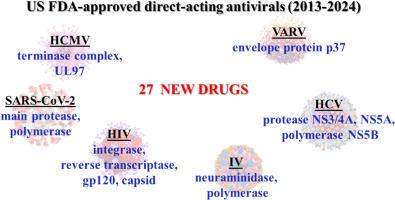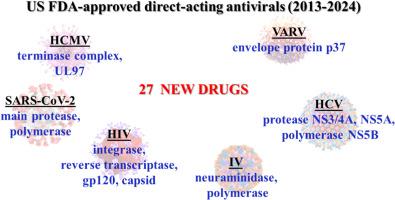A medicinal chemistry overview of direct-acting antivirals approved in 2013–2024 by US FDA
IF 5.9
2区 医学
Q1 CHEMISTRY, MEDICINAL
引用次数: 0
Abstract
Remarkable progress in understanding molecular, cellular and structural viral biology over the last ten years has paved the way for a prosperous age of antivirals. The U.S. FDA has approved 27 new direct-acting antivirals (DAAs), marking a clear step forward compared to the previous 50 years (from 1962, when the first DAA was introduced into therapy, to 2012).
Antiviral agents have been shown to play a crucial role in modern medicine, fighting infections, reducing disease severity and preventing viral spread. Their importance has been underscored during numerous global health crises affecting humans over the centuries.
In this review, we provide a comprehensive analysis of the 27 newer FDA-approved DAAs, from discovery to final approval. We focus particularly on medicinal chemistry, covering design, optimization, mechanisms of action and co-crystallographic/Cryo-EM structures. In the final section, we provide a detailed discussion of the achievements made during the period under review. Additionally, given that the current antiviral arsenal is characterized by numerous limitations and is solely effective against a small number of viruses, leaving many others without effective treatment, an overview of innovative approaches and targets that could potentially address unmet clinical needs was also provided.


2013-2024年美国FDA批准的直接作用抗病毒药物的药物化学概述
在过去十年中,对分子、细胞和结构病毒生物学的理解取得了显著进展,为抗病毒药物的繁荣时代铺平了道路。美国食品和药物管理局(FDA)已经批准了27种新的直接作用抗病毒药物(DAA),与过去的50年(从1962年第一个DAA被引入治疗到2012年)相比,这是一个明显的进步。抗病毒药物已被证明在现代医学中发挥着至关重要的作用,可以对抗感染、降低疾病严重程度和防止病毒传播。几个世纪以来,在影响人类的众多全球卫生危机中,它们的重要性得到了强调。在这篇综述中,我们提供了27个新的fda批准的daa的全面分析,从发现到最终批准。我们特别关注药物化学,包括设计,优化,作用机制和共晶/低温电镜结构。在最后一节,我们将详细讨论在审查期间所取得的成就。此外,鉴于目前的抗病毒武器库具有许多局限性,并且仅对少数病毒有效,而对许多其他病毒没有有效治疗,本文还概述了可能解决未满足临床需求的创新方法和目标。
本文章由计算机程序翻译,如有差异,请以英文原文为准。
求助全文
约1分钟内获得全文
求助全文
来源期刊
CiteScore
11.70
自引率
9.00%
发文量
863
审稿时长
29 days
期刊介绍:
The European Journal of Medicinal Chemistry is a global journal that publishes studies on all aspects of medicinal chemistry. It provides a medium for publication of original papers and also welcomes critical review papers.
A typical paper would report on the organic synthesis, characterization and pharmacological evaluation of compounds. Other topics of interest are drug design, QSAR, molecular modeling, drug-receptor interactions, molecular aspects of drug metabolism, prodrug synthesis and drug targeting. The journal expects manuscripts to present the rational for a study, provide insight into the design of compounds or understanding of mechanism, or clarify the targets.

 求助内容:
求助内容: 应助结果提醒方式:
应助结果提醒方式:


